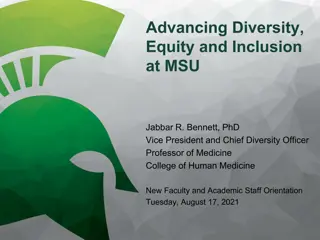Understanding Equity and Inclusion in Our Communities
Explore the concepts of diversity, inclusion, equality, and equity in our neighborhoods. Learn how representation, participation, and tailored solutions can help bridge gaps and create a more equitable society. Embrace conversations on race and equity to strive for a fairer and more inclusive community where everyone feels valued and heard.
Download Presentation

Please find below an Image/Link to download the presentation.
The content on the website is provided AS IS for your information and personal use only. It may not be sold, licensed, or shared on other websites without obtaining consent from the author. Download presentation by click this link. If you encounter any issues during the download, it is possible that the publisher has removed the file from their server.
E N D
Presentation Transcript
Dialogues on Race and Equity (DRE) DRE in Our Neighborhoods: A Discussion on Equity
Conversation Guidelines Conversation Guidelines Listen deeply - to others, to yourself We don t have to agree Accept discomfort Equity of Airtime; 3 before me - let three more people speak before you speak again Both/And - not binary; Complexity; Not either/or. Expect and accept lack of closure Use I language; Speak for yourself/own experience Lean into curiosity Remember to breathe
Diversity Diversity Speaks to REPRESENTATION. The practice of including or inviting people from a range of different social, racial and ethnic backgrounds and of different genders, sexual orientations, etc. This is the FIRST and most BASIC step.
Inclusion Inclusion Speaksto PARTICIPATION Participation from people of different races, cultures, and identities; not only in number but in terms of value, contribution and voice. A commitment to respecting, representing and embracing differences. The goal is to create an environment where all people feel like they belong and have access.
Equality Equality Everyone has the same rights, opportunities and resources. It stresses equal access. It works when the systems in place are fair. This is a one size fits all approach.
Equity Equity Recognizes the same access and opportunities for everyone (equality) doesn t truly address needs Specificsolutions and remedies - which may be different for different people - are necessary
Equality vs. Equity Equality vs. Equity Because of individual and systemicinequities, though our intent may be equality, what is needed is equity. Everyone does not start at the same place with the same resources and access. This means we need to give each person what they need to level the playing field. Those that have more may need less and those that have less may need more or different resources.
Racial Equity Racial Equity Closing the gaps so race does NOT predict one s success in any area of life, while improving outcomes for everyone. It s moving beyond providing services to focus on changing policies, structures and institutions.
Ask the questions. Ask the questions. Who benefits? Who is burdened? Who is missing? How do we know? What do we do?
What can you do? What can you do? What is your circle of influence? Do you lead a company? Do you coach a team? Do you belong to a civic organization? Are you part of a community of faith? What is your superpower?























